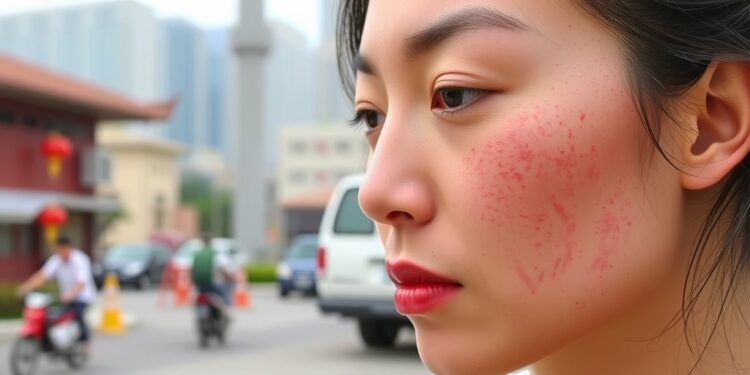In recent research conducted by a collaboration of Taiwanese and American scientists, a compelling link has emerged between exposure to PM2.5—particulate matter with a diameter of less than 2.5 micrometers—and its potential effects on skin health, specifically increased skin redness in adults. This study, published in PLOS Global Public Health, draws attention to air pollution’s insidious impact on our daily lives, extending beyond respiratory issues and into skin-related conditions that may affect millions across urban environments.
PM2.5 particles are prevalent in many parts of the world, particularly where human activity, including transportation, industrial processes, and residential heating, release these fine particulates into the atmosphere. These particles are so small that they can be inhaled, posing significant health risks by penetrating deep into the lungs and even entering the bloodstream. However, this study shifts the spotlight from its typical focus on respiratory illnesses, highlighting another critical aspect of human health—the skin.
The researchers examined a population of Taiwanese adults, tracking their levels of exposure to PM2.5 and measuring the corresponding effects on skin redness. The results showcased an alarming correlation where increased exposure to PM2.5 was associated with heightened skin redness. This condition, often a physiological response to various irritants, could indicate underlying inflammation, suggesting that air pollution might serve as a catalyst for broader skin health issues.
Air pollution has long been recognized as a major environmental health challenge; however, the focus has predominantly remained on its impact on respiratory and cardiovascular systems. This newly uncovered connection to skin health is particularly sobering. Skin, being the body’s largest organ, acts as a protective barrier and reflects internal health conditions. Chronic skin redness can lead to more severe dermatological conditions, thus increasing the urgency for further exploration into pollution’s effects on this organ.
In light of these findings, the implications of PM2.5 exposure underscore a vital public health message: urban dwellers must be vigilant not only about respiratory health but also about skin welfare. Given that cities are often characterized by high levels of air pollutants, understanding the transference of these particles into potential skin complications becomes paramount. Citizens may need to adjust their protective measures, perhaps reconsidering their skincare regimes, and adopting healthier lifestyle choices, especially in polluted areas.
The study’s authors emphasized that while the findings are significant, they are mere stepping stones toward a broader understanding of how various environmental factors might affect skin health. The interplay between external pollutants and skin inflammation warrants more in-depth research to decode its complex mechanisms. This could lead to innovative skincare solutions or public health policies aimed at reducing exposure to harmful particulate matter.
Moreover, such findings inevitably prompt questions regarding long-term exposure to air pollution and its cumulative effects on skin and overall health. As urbanization continues to rise globally, increasing numbers of individuals may find themselves facing similar challenges, linking the urgency of environmental health to personal wellness choices. Addressing this situation could range from advocating for greener urban policies to creating community awareness programs focusing on air quality.
The researchers of this study urge healthcare professionals to recognize the importance of considering environmental factors when diagnosing and treating skin conditions. This ability to forge connections between air quality and dermatological health could lead to advanced concepts in preventative measures and therapeutic approaches, benefiting not only dermatologists but also general practitioners addressing a range of health issues.
As urban populations deepen their understanding of pollution’s health effects, there lies a potential for activism at multiple levels. Citizens and advocacy groups could unite to push for stringent regulations on emissions, sustaining efforts to clear the air for future generations. Such actions could fundamentally reshape not just public health but also the landscape of urban living, turning cities into healthier spaces.
Finally, given the gravity of the findings, the researchers call upon policymakers and public health officials to prioritize air quality initiatives and further research into the effects of pollution on skin health. This knowledge could significantly influence regulatory decisions, potentially leading to a decrease in pollution levels and an improvement in quality of life, as communities strive for a healthier environment.
In conclusion, the emerging connection between PM2.5 exposure and skin redness reiterates a pressing call to action. As stakeholders across the spectrums of health, environment, and governance engage with this information, collective efforts can foster a robust response addressing one of the many facets of air pollution’s health toll. Better awareness, robust regulations, and community engagement could pave the way for healthier skin and a healthier future.
Subject of Research: Association between PM2.5 exposure and skin redness in Taiwanese adults
Article Title: Association between PM2.5 and skin redness features in Taiwan
News Publication Date: 12-Mar-2025
Web References: 10.1371/journal.pgph.0004357
References: Not applicable
Image Credits: Not applicable
Keywords: PM2.5, air pollution, skin health, dermatology, environmental health, Taiwan, public health
Tags: air pollution effects on skin healthenvironmental factors affecting skinhealth risks of fine particulate matterimpact of air pollution on human healthparticulate matter and dermatological conditionsPM2.5 exposure and skin rednesspublic health implications of air qualityrespiratory and skin health correlationskin irritation from air pollutantsTaiwanese adults skin health studyurban air quality and skin issuesurban environments and skin conditions





